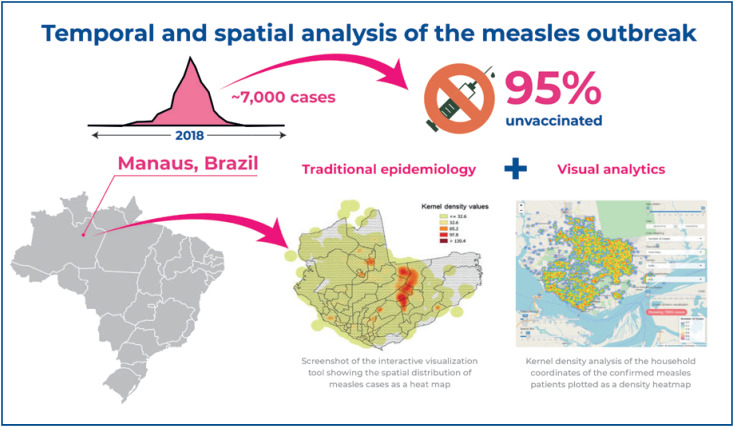Temporal and spatial analysis of over 7,000 measles cases outbreak from 2018 to 2019 in the Brazilian Amazon.
OBJECTIVE: This study aimed to present a temporal and spatial analysis of the 2018 measles outbreak in Brazil, particularly in the metropolitan city of Manaus in the Amazon region, and further introduce a new tool for spatial analysis. METHODS: We analyzed the geographical data of the residences of over 7,000 individuals with measles in Manaus during 2018 and 2019. Spatial and temporal analyses were conducted to characterize various aspects of the outbreak, including the onset and prevalence of symptoms, demographics, and vaccination status. A visualization tool was also constructed to display the geographical and temporal distribution of the reported measles cases. RESULTS: Approximately 95% of the included participants had not received vaccination within the past decade. Heterogeneity was observed across all facets of the outbreak, including variations in the incubation period and symptom presentation. Age distribution exhibited two peaks, occurring at one year and 18 years of age, and the potential implications of this distribution on predictive analysis were discussed. Additionally, spatial analysis revealed that areas with the highest case densities tended to have the lowest standard of living. CONCLUSION: Understanding the spatial and temporal spread of measles outbreaks provides insights for decision-making regarding measures to mitigate future epidemics.
Authors
Martins FM, Vidal AP, Giddaluru J, da Silva BM, Lee EK
External link
Publication Year
Publication Journal
Associeted Project
Digital Epidemiology
Lista de serviços
-
As antisense RNA gets intronic.As antisense RNA gets intronic.
-
Androgen responsive intronic non-coding RNAs.Androgen responsive intronic non-coding RNAs.
-
Conserved tissue expression signatures of intronic noncoding RNAs transcribed from human and mouse loci.Conserved tissue expression signatures of intronic noncoding RNAs transcribed from human and mouse loci.
-
The intronic long noncoding RNA ANRASSF1 recruits PRC2 to the RASSF1A promoter, reducing the expression of RASSF1A and increasing cell proliferation.The intronic long noncoding RNA ANRASSF1 recruits PRC2 to the RASSF1A promoter, reducing the expression of RASSF1A and increasing cell proliferation.
-
Antisense intronic non-coding RNA levels correlate to the degree of tumor differentiation in prostate cancer.Antisense intronic non-coding RNA levels correlate to the degree of tumor differentiation in prostate cancer.
-
Insight Into the Long Noncoding RNA and mRNA Coexpression Profile in the Human Blood Transcriptome Upon Leishmania infantum Infection.Insight Into the Long Noncoding RNA and mRNA Coexpression Profile in the Human Blood Transcriptome Upon Leishmania infantum Infection.
-
Long non-coding RNAs associated with infection and vaccine-induced immunityLong non-coding RNAs associated with infection and vaccine-induced immunity
-
Comparative transcriptomic analysis of long noncoding RNAs in Leishmania-infected human macrophagesComparative transcriptomic analysis of long noncoding RNAs in Leishmania-infected human macrophages
-
SARS-CoV-2 Selectively Induces the Expression of Unproductive Splicing Isoforms of Interferon, Class I MHC, and Splicing Machinery Genes.SARS-CoV-2 Selectively Induces the Expression of Unproductive Splicing Isoforms of Interferon, Class I MHC, and Splicing Machinery Genes.

